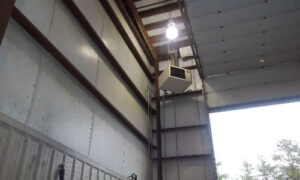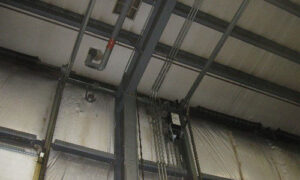SECTION 1 – INTRODUCTION
This document outlines Compressed Natural Gas (CNG) properties, design standards and modification of existing CNG vehicle maintenance facilities, CNG training and related CNG code requirements. Please note that the design guidelines in this document are general. The unique nature of various individual facilities, specific local codes and the interpretation of the codes by local officials, necessitate evaluation and design of each individual site on a case-by-case basis.
Codes, and interpretations thereof, aside there is no substitute for sound engineering judgment. ET Design-Build | ET Environmental (ET) has performed more than 100 CNG maintenance facility upgrades and can attest there is no “one size fits all” configuration. A review meeting with local authorities is recommended to establish concurrent code interpretations.
This document
SECTION 2 – GAS PROPERTIES (CNG)
Compressed Natural Gas (CNG) fuel differs from gasoline and diesel fuels. Basic differences between gaseous and liquid fuels that influence maintenance facility modification are as follows:
- Natural gas is lighter-than-air and is in a gaseous form at atmospheric conditions. This property allows natural gas fuel to quickly rise and disperse in the unlikely event of a leak. Although lighter-than-air fuel has safety advantages, ceilings of these facilities need to be properly ventilated to quickly and automatically remove the risk caused by a leak, using ventilation to dilute and then vent any leaked gas.
Liquid fuels such as gasoline and diesel will form a pool of liquid with a heavier-than-air vapor phase above. Liquid fuels remain in a concentrated form after a leak, causing on-going safety and environmental concerns. - The mixture of natural gas in air that will support combustion is between 5% and 15% by volume. Ratios outside this range will not support combustion.
Liquid fuel leaks will pool and therefore will remain in flammable or explosive mixtures until the leak is manually contained and cleaned-up. - CNG has an ignition temperature of around 900 to 1,200 degrees Fahrenheit (°F), gasoline is approximately 500°F to 800°F and diesel is less than 500°F. The higher ignition temperature of CNG is an additional safety feature over gasoline and diesel. To ensure a safe environment in the maintenance facility, the surface temperature of equipment that could come in contact with gas from a leak is limited to less than 750°F.
SECTION 3 – BASIS OF DESIGN (MAINTENANCE FACILITIES)
This section summarizes features and approaches that are common to CNG vehicle maintenance facilities (shops):
Code
There are numerous code requirements that are specific to maintenance facilities for CNG-fueled vehicles. A summary of applicable codes is included in Section 5 of this document. Each existing facility should be evaluated individually for code applicability.
It is assumed that existing repair facilities comply with basic applicable code requirements for Major Repair Garages or were compliant at the time of construction (i.e., they are “grandfathered”). In some cases, however, local jurisdictions may mandate bringing non-conforming systems into compliance as a condition of approval.
Ventilation Systems
Section 2311 of the International Fire Code (IFC) and Section 510 of the International Mechanical Code (IMC) require facilities used for the repair of natural gas vehicles to provide either continuous mechanical ventilation or ventilation activated by a continuously monitored gas detection system. The ventilation rate must be one cubic foot per minute (cfm) per twelve cubic feet (ft³) of shop volume (e.g. around 15,000 cfm for a typical 3-bay shop with a 25’ high ceiling).
The method of compliance may vary according to climatic conditions at the facility.
- Heated Shop – If the shop is heated, emergency ventilation will typically be provided with a mechanical exhaust system which is activated in the event of gas detection.
- Un-Heated Shop – If the shop is un-heated, continuous ventilation may be an optional path for code compliance. Occupant comfort must be considered based on the local climate because the introduction of the volume of airflow may feel drafty to occupants even in moderate climates.
Emergency CNG ventilation is typically provided with fans mounted at the high point of the shop space to exhaust gases which are lighter-than-air. Intake air can be introduced in the event of gas detection with either louvers or by triggering motors for overhead doors to open.
Sloped Roofs
New CNG garages tend to use sloped roofs with relatively open structural systems to prevent pocketing. Existing garages need to be evaluated with respect to the building’s structural components. Analysis needs to be performed to determine if there are components of the roof and walls that impede the flow of gas to detection equipment and to determine proper separation of CNG repair areas and non-CNG repair areas.
Heating Systems
Chapter 7 of the National Fire Protection Association (NFPA) 30A prohibits open flame heaters and heating equipment with exposed surfaces greater than 750°F in CNG vehicle repair shops. Compliance with this requirement is on a case-by-case basis and is dependent on the type of existing heating system currently in-place. If the repair shop is equipped with a forced hot-air heating system or a radiant in-floor heating system, upgrade of the heating equipment may not be necessary. Also, it may be possible to retrofit some types of radiant open-flame heaters. If a retrofit is not possible, replacement with an enclosed-flame heater shall be necessary.

Electrical
In a major repair garage that repairs CNG vehicles, the area within eighteen-inches (18”) of the ceiling is designated as a Class 1 Division 2 hazardous (classified) location. To comply with NFPA 70 also known as the National Electric Code (NEC), all lighting, electrical conduit and any electrical ventilation equipment will either need to be lowered below the classified location or replaced with equipment designed for use in a classified location (i.e. explosion proof).

Gas Detection
Chapter 7 of the National Fire Protection Association (NFPA) 30A requires that facilities used for the repair of natural gas vehicles be provided with an approved flammable gas detection system.
Two types of sensors are commonly used in a gas detection system:
- Catalytic Bead – a “passive’ technology that is based on the principal that when gas oxidizes it produces heat. The sensor detects this heat differential. Advantages of catalytic sensors are that they have long life with a low replacement cost, can perform more reliably in dusty and dirty environments and are less sensitive to humidity and condensation. Disadvantages are that they commonly require quarterly calibration (verify with manufacturer) and sensor replacement every 2-3 years.
- Infrared – an “active” technology based on an IR source emitting a signal many times a second, and the amount of energy falling on the detector serves as an active measure of the gas concentration at that moment. Advantages of infrared sensors are that they outlast catalytic sensors, only require yearly calibration and they can be used for “point” (single location) or “open path” (line of sight) applications. Disadvantages are that they have a higher initial cost, high humidity and dusty field environments can increase the infrared sensor’s maintenance costs, limited temperature range for detector use compared to catalytic detectors and any failure of the source or detector, or blockage of the signal by dirt, is detected immediately as a malfunction.
Chapter 7 of NFPA 30A states that the gas detection system shall be designed to activate when the level of flammable gas exceeds 25 percent of the lower flammable limit (LFL). The sensors are tied to a panel that typically sounds an alarm, initiates supplemental exhaust systems, disables the buildings heating system, opens intake louvers or overhead doors, and shuts down power to select circuits using breakers with “shunt trips.”
Stand-by Generator
To ensure continuous monitoring and protection, a small back-up generator for stand-by power may be installed to operate the detection and emergency ventilation systems in the event of a power outage. This feature is at the owner’s discretion, with the criteria being whether maintenance will continue during a power outage. In the absence of stand-by power, the detection system should be equipped with an uninterruptible power supply (UPS) with a minimum 8-hour battery life.
Vehicle Defueling
Vehicles that require fueling system maintenance or certain other repairs need to be defueled. Defueling can be accomplished two ways; through a defueling post that recycles the onboard gas back through the CNG facility’s compressor or through a venting post that vents the onboard gas to the atmosphere. The methodology employed will be dependent upon several factors, including state and local environmental regulations.
SECTION 4 – CNG TRAINING FOR MAINTENANCE PERSONNEL & FIRE DEPARTMENTS
The recommended minimum training for personnel is as follows:
- Operation and servicing of vehicle fuel systems.
- Orientation of the maintenance facility for local fire departments, including locations of shutoffs, hydrants, gas detection, ventilation/exhaust, and alarm system.
- It is typical for companies with a large vehicle fleet to produce emergency-response information for each series of truck they operate – showing the location of isolation valves, fire-system controls, contact numbers and other information of interest to a first responder.
SECTION 5 – APPLICABLE CODES
CNG facilities are designed and built to NFPA, IFC and IMC codes and standards. As noted in the introduction, the adoption of applicable codes and specific revisions varies by jurisdiction and must be evaluated for every site. Listed below is a brief description of the most frequently references codes at the time of this writing:
- National Fire Protection Association (NFPA) 30A – Motor Fuel Dispensing Facilities and Repair Garages – Provides rules for piping, fuel dispensing systems, service stations inside buildings, and the full range of operations.
- NFPA 52 – Vehicular Natural Gas Fuel Systems Code – Provides the latest fire safety rules for compressed natural gas (CNG) fuel systems and liquefied natural gas (LNG) systems on all vehicle types — plus their respective compression, storage, and dispensing systems.
- International Fire Code (IFC) – Regulates minimum fire safety requirements for new and existing buildings, facilities, storage, and processes. The IFC addresses fire prevention, fire protection, life safety and safe storage and use of hazardous materials in new and existing buildings, facilities, and processes. The IFC provides a total approach for controlling hazards in all buildings and sites, regardless of the hazard being indoors or outdoors.
- International Mechanical Code (IMC) – Designed to provide comprehensive regulations for mechanical systems and equipment, it includes coverage of HVAC, exhaust systems, chimneys and vents, ducts, appliances, boilers, water heaters, refrigerators, hydronic piping, and solar systems. This valuable reference uses prescriptive- and performance- related provisions to establish minimum regulations for a variety of systems.
- In addition to the above mentioned federal-level guidelines, state and municipal level standards may also need interpretation, addressing and implementation.
For additional information:
Steven R. Roos, Lead Engineer – Energy | 909-734-4362 | sroos@etdesignbuild.com
etdesignbuild.com | info@etdesignbuild.com